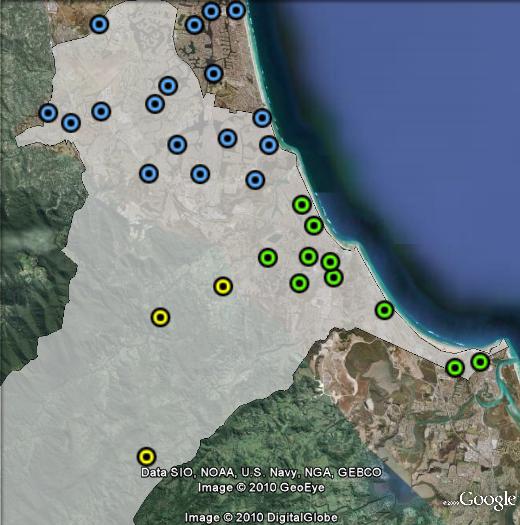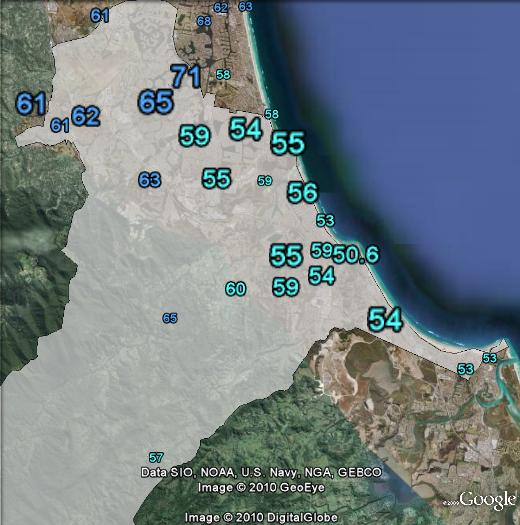LIB 8.6%
Incumbent MP
Margaret May, since 1998.
Geography
Southern end of the Gold Coast. McPherson covers the Gold Coast’s border with New South Wales and stretches up the coast to Burleigh Heads and covers inland Gold Coast as far north as Clear Island Waters and Merrimac.
Redistribution
McPherson contracted, losing rural areas in the Gold Coast hinterland to the new seat of Wright, including Austinville, Bonogin and Neranwood. There were no changes to the seat’s boundaries along the coast.
History
McPherson was created as part of the expansion of the House of Representatives in 1949, and it has always been held by Coalition parties: by the Country Party until 1972 and by the Liberal Party ever since.
The seat was first won in 1949 by Country Party leader Arthur Fadden, who became Treasurer in the post-war Menzies government. Fadden had briefly served as Prime Minister during the Second World War and had previously held Darling Downs since 1936.
Fadden held the seat until his retirement in 1958, when he was replaced by the Country Party’s Charles Barnes. Barnes served as a minister from 1963 until just before the 1972 election, and retired at that election.
At the 1972 election the seat of McPherson was lost by the Country Party to Liberal candidate Eric Robinson. Robinson served as a junior minister in the first term of the Fraser government and was appointed Finance Minister in 1977. He briefly stood down in 1979 due to a dispute with Malcolm Fraser, and was dropped from the ministry after the 1980 election. He died suddenly in January 1981.
The 1981 by-election was won by state Liberal MP Peter White, who defeated National Country Party senator Glen Sheil. White held McPherson at the 1983, 1984 and 1987 elections, and retired in 1990.
McPherson was won in 1990 by the Liberal Party’s John Bradford. Bradford held the seat until 1998. In April 1998 he resigned from the Liberal Party and joined the Christian Democratic Party. He contested the Senate in Queensland in 1998 for the CDP but was not elected.
McPherson was won in 1998 by Margaret May, who has held the seat for the last decade. May briefly served as a shadow minister under Brendan Nelson and Malcolm Turnbull but has since returned to the backbench, and is retiring in 2010.
Candidates
- Matthew Reeves (Family First)
- Dan Byron (Labor)
- Karen Andrews (Liberal National)
- Ben O’Callaghan (Greens)
Political situation
This seat is a safe Liberal seat and should be easily retained. The Liberal National Party was preselected after defeating Liberal frontbencher Peter Dutton, who attempted to move from his marginal seat in northern Brisbane.
2007 result
| Candidate | Party | Votes | % | Swing |
| Margaret May | LIB | 45,979 | 54.98 | -3.96 |
| Eddy Sarroff | ALP | 29,798 | 35.63 | +5.55 |
| Ben O’Callaghan | GRN | 4,986 | 5.96 | +0.79 |
| Kevin Davis | FF | 1,282 | 1.53 | -1.30 |
| Lori Carnwell | DEM | 791 | 0.95 | -0.13 |
| Tyrone Jackson | IND | 666 | 0.80 | +0.80 |
| Geoff Cornell | CEC | 127 | 0.15 | +0.10 |
2007 two-candidate-preferred result
| Candidate | Party | Votes | % | Swing |
| Margaret May | LIB | 49,195 | 58.83 | -5.11 |
| Eddy Sarroff | ALP | 34,434 | 41.17 | +5.11 |
These results do not take into consideration the effects of the redistribution.
Booth breakdown
Most booths in McPherson are dotted along the coast. I have set aside the three booths away from the coast as “West”, then divided the coastal booths between “North” and “South”. The Liberal Party polled just over 60% in booths in the North and West, but less than 55% in the South.

| Voter group | GRN % | LIB 2CP % | Total votes | % of ordinary votes |
| North | 5.22 | 60.50 | 35,280 | 56.24 |
| South | 6.82 | 54.49 | 24,324 | 38.78 |
| West | 7.78 | 60.70 | 3,125 | 4.98 |
| Other votes | 5.75 | 60.45 | 18,594 |



The booths in Springbrook (284 voters in 2007) and Bonogin (2022 voters in 2007) both transfer to the new electorate of Wright.
Bonogin was a strong Liberal Booth (66% to Liberal, 2PP in 2007)
Springbrook was a better Labor Booth (57% to Labor, 2 PP in 2007) but was also the smallest booth in the electorate.
Can anyone explain why the Gold Coast is so conservative?
I can’t think of any other middle-income, metropolitan area that votes so heavily for the Libs. Sydney’s North Shore and Melbourne’s Eastern Subs are very wealthy, which is an explanation for them, but there really isn’t any other ultra-safe city seats that aren’t high-income. Thoughts?
Shark
Ben has those two booths on the Wright map. Springbrook had a 20% Greens vote.
Hamish
Yeah, I wonder why too. Why too doesn’t it swing like outer-suburban seats?
Labor did make some noises about possibly winning this seat in 2007, but it was never going to happen, although the candidate was a well-known local councillor.
I was going to say that there was a big retiree population, but looking at the census figures that doesn’t show up, indeed, most stats are pretty close to the national averages. The one thing the seat does have is plenty of New Zealanders – three times as many as the national average.
Hamish – I also have real trouble understanding the conservatism of the Gold Coast seats. The only thing I can think of is the mortgage-belt profile of the seats, perhaps? Or maybe they’re the kind of seats attracting country-to-city migration from rural Qld areas?
One thing that’s nagging me as a possible cause is the presence of Bond University in the seat, the only private uni in the country. Couple that with the above average number of 20-29 yr olds in neighbouring Moncrief, and perhaps we seeing the influence of wealthier, more conservative uni students? The problem with this scenario, though, is that Bond Uni only has 3,000 students. The freaky thing I found was, using Possum Pollytics electoral gizmo, that the most comparable area demographically with the three Gold Coast seats are the three Hunter seats – which sounds crazy. But they have similar age profiles, similar employment, labour and occupation figures and similar social profiles (with the exception that the Gold Coast seats have far higher proportions born overseas, which seems counter-intuitive).
Interesting comparison with the Hunter seats. Perhaps that demonstrates the limitations of some of these demographic measures, since there’s clearly big cultural differences. Probably it is ultimately a cultural thing – GC is very much ‘aspirational’ territory – a place people go to make money. People don’t move there for a sea-change, they move there to move up in the world.
Also, another trend would seem to be increasing numbers of people living on the GC and commuting to Brisbane. Both traffic on the motorway, and passenger numbers on the rail line, have continually surpassed forecasts over the past decade.
Jimmy,
The 2007 Federal Election saw Bond University Adjunct Ben O’Callaghan run – for the GREENS.
http://environmentaustralia.com.au/keystaff.php
Shark1975 – that’s great. What I suggested was just speculation.
The Gold Coast is a political puzzle. Federal Labor seems to underperform compared to the state ALP however even when the higher state ALP vote is taken into account.
The 2007 Greens candidate, Ben O’Callaghan, will also contest the 2010 Election.
Why wedge the federal ALP candidate for McPherson when you can do it to his boss (the State Member for Burleigh):
http://www.goldcoast.com.au/article/2010/07/14/238351_gold-coast-news.html
My prediction: 2-3% swing to LNP.